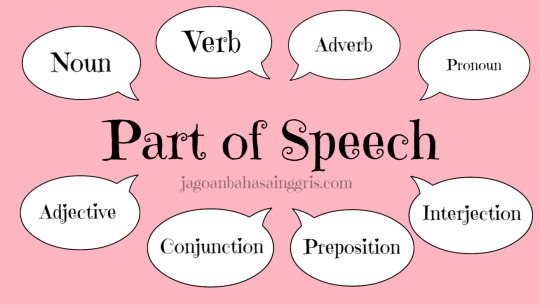Text
PART OF SPEECH

My name is Wa Ode Zithaul Ainan, I am a student from Halu Oleo University, Department of English Education, Faculty of Teacher Training and Education.
Here I will explain about Part Of Speech.
Part of speech is part of English grammar in the form of a classification of words which are divided into several categories based on their role and function in the structure of a sentence. By knowing the part of speech one can know the function of the word in a sentence. In addition, part of speech is the first step that you need to learn when learning English, its use is to understand sentence forms in English.
There are 8 kinds of Part Of Speech, namely noun, pronoun, verb, adjective, adverb, preposition, conjunction, interjection. Here is the explanation!

1. NOUN
Nouns are used to name people, things, animals, places, and ideas or concepts. Nouns themselves can be further divided into various types, such as countable, uncountable / mass, common, proper, concrete, abstract, and collective nouns.
Types of nouns and examples:
Countable (can be counted) = Book, Elephant, Train
Uncountable / Mass (uncountable) = Love, Sand, Happiness
Common = Country, City, Month
Proper (Something specific) = Switzerland, Jakarta, January
Concrete (Something tangible) = Bag, Cake, Building
Abstract (Stating ideas, concepts, circumstances, and other abstract things) = Friendship, Time, Imagination
Collective (Refers to a group of people, animals, or things) = Deer, Family, Government.
2. PRONOUN
A pronoun is a word that is used to replace a noun. There are 8 types of pronouns, namely personal, demonstrative, interrogative, indefinite, possessive, reciprocal, relative, reflexive, and intensive pronouns.
Types of pronouns and examples:
Personal = I, We, He, She
Demonstrative = This, That, These, Those
Interrogative = Who, Which, What, Whom, Whose
Indefinite = Nothing, Someone, Anywhere, Everybody
Possessive = Mine, Yours, Hers, His
Reciprocal = Each other, One another
Relative = = Who, Which, Whom, Whose
Reflexive = Myself, Yourself, Ourselves, Themselves
Intensive = Himself, Herself, Ourselves, Themselves
3. VERB
Verb is a verb that is used to indicate an action or state. Verbs can be divided into several types, such as action verbs and linking verbs.
Types of verbs and examples:
Action Verb (Transitive) - Indicates an action or possession, and is followed by a direct object. Example: Have, Give, Ride
Action Verb (Intransitive) - Indicates an action, not followed by a direct object. Example: Arrive, Rise, Wait
Linking Verb - Linking the subject and its description. Example: Be, Taste, Remain
4. ADJECTIVE
Adjectives are adjectives that are used to describe a noun or pronoun.
Example: Pretty, Sad, Faithful
5. ADVERB
As an adverb, the function of an adverb is to provide additional information on the verb, adjective, or adverb itself. Adverbs can also be grouped into several types, such as manner, degree, frequency, place, and time.
Types of adverbs and examples:
Adverb of Manner = Well, Softly, Quickly
Adverb of Degree = Just, Almost, So
Adverb of Frequency = Usually, Always, Rarely
Adverb of Place = In, Above, Below
Adverb of Time = Annually, Daily, Yesterday
6. PREPOSITION
The function of prepositions is to show the relationship between nouns and other words in a sentence.
Example: In, On, At, Through, With, By, Of
7. CONJUNCTION
Conjunction is used to connect two words, phrases, clauses to sentences. There are 3 types of conjunctions, namely coordinating, subordinating, and correlative conjunctions.
Types of conjunctions and examples:
Coordinating Conjuction - Connects 2 grammatical forms that are the same, for example word by word. Example: For, And, Nor, But, Or, Yet, So
Subordinating Conjuction - Connects the main clause and subordinate clause. Example: After, Since, Although
Correlative Conjuction - A pair of conjunctions. Example: Not only….but also, Either…or
8. INTERJECTION
This type of word is usually used to express emotions.
Example: Oops, Whoa, Oh no!
Those are the various parts of speech in English. Are you now able to distinguish one type of part of speech from another?
May be beneficial to us all!

3 notes
·
View notes